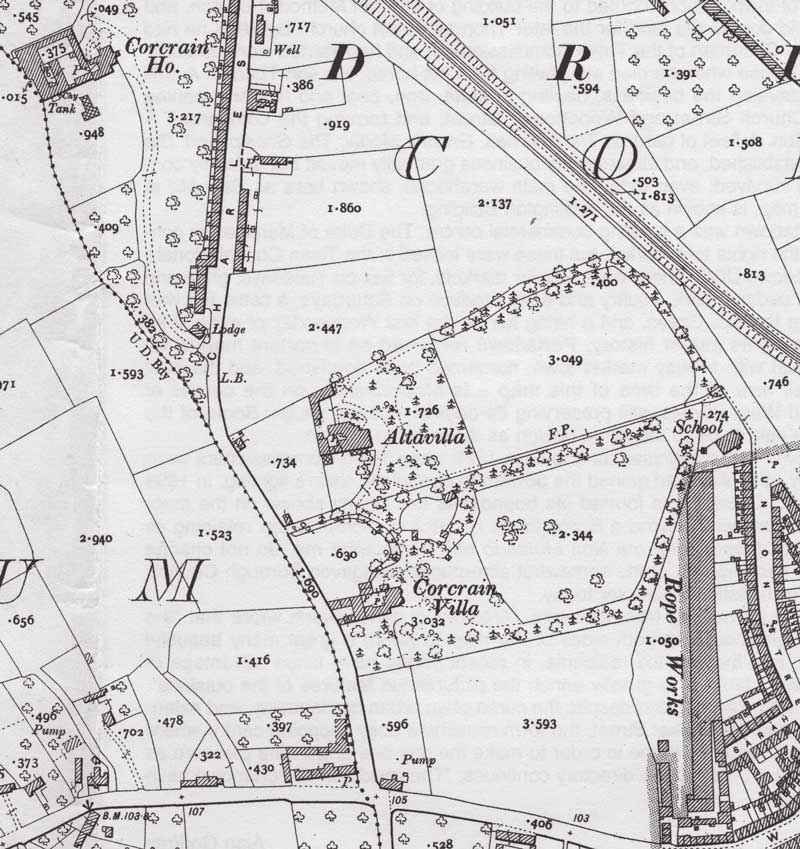Charles Street/Charlies Walls or Dawsons RowCorcrain House |
|
Charles Street or better known as Charlies Walls, some referred to the row of houses as Dawson's Row. The line drawing was made before 1888. The row of house's and Corcrain House remained until the 1960's All were demolished by the local council making way for the present Corcrain Housing Estate and 'The Oaks' sheltered residential home for the elderly. To this day part of the stone of the row of houses remain, when being demolished about three foot of the stone at the front of the houses was retained, where the doorways used to be stone taken from the upper part of the houses was used to fill the gap. To the left of above image the Hart Memorial School was built about 1930. During the second World War American troops were encamped on the Dawson Estate, they brought much colour to our town as well as taking quite a few brides back to the States. Here follows a description of the Dawson Estate as written by George Henry Bassett in 1888. Thomas Dawson Linen & Cambric Handkerchief Manufacturer and Bleacher, Steam Winder, Yarn boiler and Preparer. Machine Hemstitcher, &c., Corcrain House, Portadown. Mr. Thomas Dawson's enterprise at Corcrain House, has been in a state of active development since 1872. In May of that year he became owner in perpetuity. Linen manufacturing by hand loom was begun here in 1840 by Mr. Joseph Druitt. He became lessee of Corcrain House, the handsome residence now occupied by Mr. Dawson, and built the stores and offices in connection with his trade, thirty of the workers' houses, and the porter's lodge seen in the illustration. Mr. Dawson, since his accession, has made considerable alterations and extensions, including the erection of a hemstitching factory. He also added departments for yarn boiling, preparing, and winding. About 400 hand-loom weavers were employed in the manufacture of linen and cambric handkerchiefs, about 60 inside and 30 outside hands in connection with the hemstitching factory, and from 20 to 30 in the yarn boiling and preparing departments. Steam machinery was also introduced by Mr. Dawson. The buildings are principally of stone and slate. Belfast is Mr. Dawson's market. Corcrain House, grounds, factory and premises embrace over fifteen statute acres. The grounds are tastefully planted and laid out. Trees of many varieties flourish in them. Among those in greatest perfection are beech, ash, birch and oak. There are some choice specimens of Portuguese and common laurel, Irish yew, holly-common and variegated-a splendid array of rhododendrons. Corcrain House is within the town boundary. It is about three quarters of a mile from the Railway station. The Corcrain river bounds the property on the west, and the Great Northern Railway on the north. 1906 Map- Part of Corcrain Area
1906 - Corcrain area continues beyond top of map, bottom right is part of Edgarstown area, and bottom left the Loughgall Road area. Corcrain House once the home of the Dawsons/Atkinsons is now the site of 'The Oaks' sheltered housing and Corcrain Housing Estate. Altavilla once the home of Averill Shilington now St. Francis Nursing Home. Corcrain Villa once the home of Charles F. Wakefield, most likely where the street name originated, the building was demolished, replaced by new building, home of James Finlay, owner of Savoy Restaurant in West Street, his home became Parochial House of RC Church, that building was demolished about 2002 site being used for development of present private Housing Estate. The plot below Corcrain Villa which bounds Charles Street and West Street is now Greenview Gardens. Site opposite Altavilla is where Hart Memorial Primary School stands.. The rope works in Edgarstown area was owned by the Logans.
|

